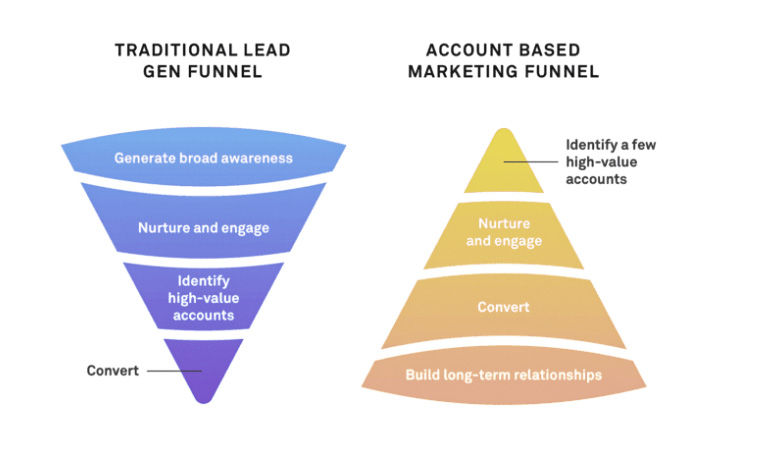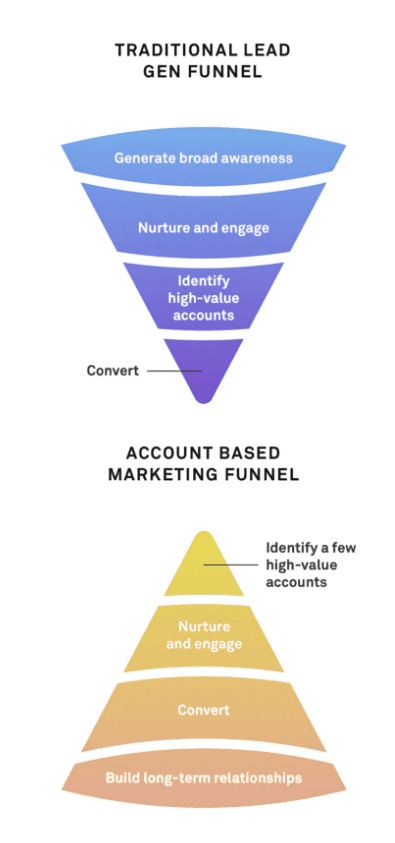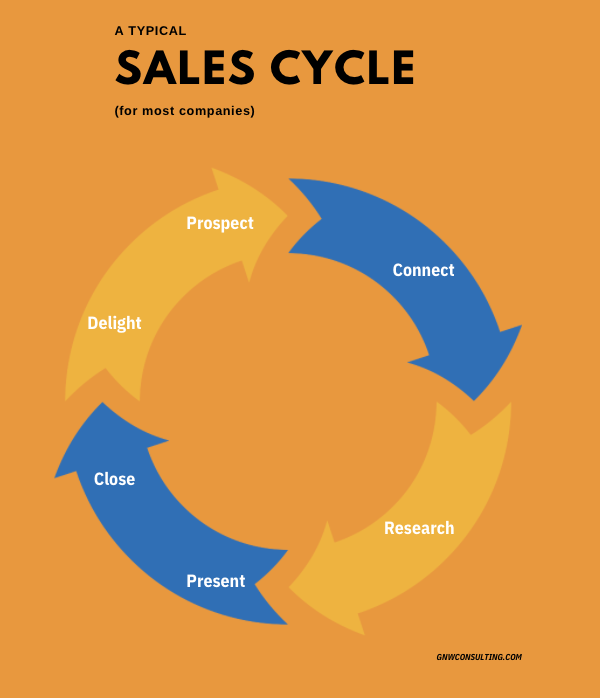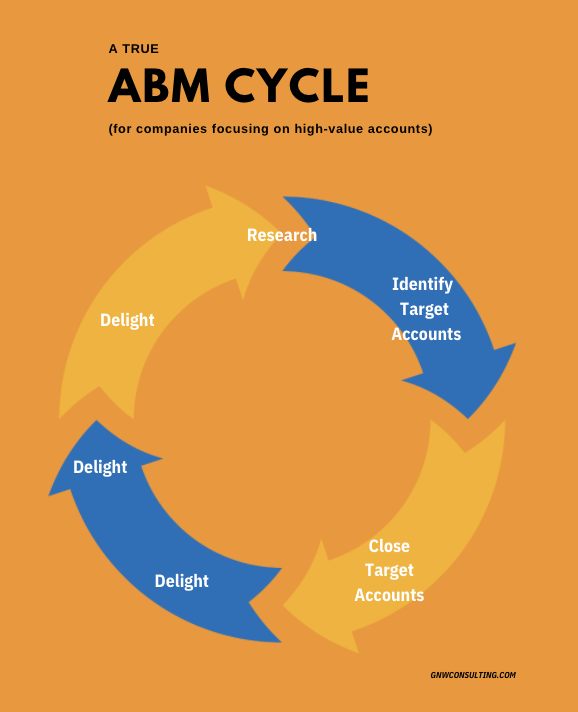As a strategic marketing consulting agency, a topic we often get asked about is account-based marketing. What is it? Why is it important? Is this something my organization could even do? Here are the fundamentals of ABM that regardless of what marketing automation platform you use can be applied.
What is Account Based Marketing?
Account-based marketing (ABM) is a strategic business marketing approach that focuses on building awareness by identifying a set of companies or businesses to target, then engaging them with personalized content or conversations to build relationships that could lead to new opportunities over time.
It’s an inverse of inbound marketing, which focuses on lead generation to determine who your targets or accounts are. It also takes a more holistic view of marketing in that it uses personalization at every step of the journey to engage each account.
While ABM differs from business-to-business, it can drastically improve your ability to upsell and cross-sell to your existing customer base to get the most value out of existing customers.


The second step in an ABM funnel, much like a traditional inbound approach, is to nurture and engage your high-value accounts. Rather than wait for conversion at some point in the relationship, ABM done right can result in a few key benefits, namely shorter sales cycles and…
- More Personalized Marketing – Instead of leading prospects upstream with evolving messaging, you’ll have the data you need to tailor creative assets and messaging to your customer’s unique attributes and needs.
- Achieving Sales & Marketing Alignment – Some have said this isn’t possible, but we’re here to tell you good ABM requires your teams to join forces from the moment you identify high-value accounts, through nurture and engagement and on to building those long-term relationships that lead to more sales.
- Clear Views; Shorter Sales Cycles – As we mentioned, ABM does lead to short sales cycles, which in turn leads to a clear picture of what your expected ROI could be.
- More Time For What Matters – When you’re spending less time waiting for customers, you can be more proactive. By focusing on a small number of accounts that are more likely to convert, you’re not spending time testing upper funnel tactics, leading to more time and fewer resources wasted.
Is my organization ready for ABM?
So, now that you’ve been introduced to ABM and considered the benefits, I’m sure your next question is “well… am I ready for this?” To put things into perspective, let’s talk through a few scenarios where ABM excels and delivers on all of its various benefits and promises.
Account-based marketing is all about creating meaningful brand experiences right from the start, so it really requires an understanding of where your audiences are most engaged and how you can deliver personalized messaging to them on those set channels. There’s no “cookie-cutter” strategy for ABM, each business will have a customized strategy unique to their client roster, but here are a few channels and tactics where we’ve seen the most success:
Events
This is hands-down the most fruitful ABM territory. Now that events are making a comeback, we highly recommend starting here. An ABM approach to events is all about personalized invitations, emails, swag… the full VIP experience. Even if your event is taking a hybrid approach, we know a thing or two about making the digital experience as impressive as the physical.
Webinars
This territory is much like the first, but here we recommend you find topics specific to an industry or customer you’re targeting. Whether you’re trying to help clients leverage an existing tool or simply pushing sales for a timely campaign, there’s much potential in the upsell and cross-sell territory through webinars.
Direct Mail
Sometimes receiving something straight to your doorstep is the most personalized approach possible. We recommend determining what your revenue potential is per customer, then identifying unique opportunities to send something that can really keep your brand top of mind. Don’t be afraid to delight with this tactic.
Digital Experiences – Email, Paid Ads and More
Email campaigns and paid advertising are a no-brainer. You’ll need to leverage tailored messaging for each company and individual. Platforms like LinkedIn and Facebook are a great place to start but don’t forget to cast a smaller net, so consider using tactics like IP targeting and remarketing.
Keep in mind that web personalization can really drive the message home. If they get the trifecta of an email, ad, and web visit that feels personalized, they’ll be more interested in the message you’re putting out there. It’s all about making them stop in their tracks, so don’t be afraid to think holistically.
“ABM is about building quality relationships, so hurry up and be patient for your customers to adjust to a new way of doing business with you. ” - Raja Walia
Okay, now that we’ve covered a few examples, this is what you really have to ask yourself to determine your organization’s readiness for this tactic. You can start with this handy checklist, but here’s the skinny on what you need to know about being ready for ABM.
Have you dug deep?
It’s all about doing the research, do you have the high-value targets in mind? How are you currently nurturing those prospects? You need to have a deep understanding of your current process to be able to reverse, inverse or even uproot the current flow of messaging to your accounts.
Are you measurement ready?
This is the one most people struggle with because it’s a blend of technology and strategy. You need to ensure you have a reliable KPI framework in place, then build up your tech to capture all the information you need to develop customized marketing campaigns.
Do you have the right content?
It’s not just about existing content, but you need to ensure you’ve filled the content gaps you need to fill to be able to create a net-new experience for your customers.
Is your team ready?
It doesn’t matter if the tech and content are in place, you need to have a dedicated (and fully trained) team to make it happen. There’s a lot of coordination involved across marketing sales and operations, so be sure to have a fully built team to ensure everyone’s owning their respective channels to find connections. Remember, you need to make sure your team has both online and offline channel specialists.
Best practice tip: ABM Campaigns are always multi-channel
This is what you need to be prepared for ABM marketing, we know it can be a bit of a lift – it’s why teams like you hire people like us! We’ve got the martech tools and experience to tell you what works and doesn’t work early on. It’s always more cost-effective to avoid the pitfalls the first time around.
Understand the basis of ABM Scoring
Speaking of pitfalls, it would be almost negligent to not talk about ABM scoring. Depending on your business, you’ll be required to streamline your sales cycle. Here’s a look at how a typical sales cycle differs from an ABM sales cycle:


As you can see, the process is much more focused on a unique set of individuals and the respective steps it takes to win them over. Rather than experimenting with different tactics to help prospects and qualify, you’re relying on identifying accounts that are truly ripe for conversion.
Truly understanding the potential value of prospects is the foundation for ABM lead scoring, you need an honest, accurate method of calculating the expected value of a said lead to determine what priority they’re in and when they can enter the ABM cycle.
This should not be a “universal” score, no two leads are the same, but rather this score should tie back directly to your business interests.
Determine what type of activities drive the most value back to you and find leads that have engaged with those on multiple occasions, whether it be a sale in the last 2 weeks or simply location, it’s up to you to decide what types of activities fit into your ideal customer profile and how they’re valued.
Leverage the tools at your disposal
One last thing to know about ABM is that you need the right tools to do it and the right training on those tools. Your teams are going to be starting up conversations left and right. Consider the following tools for your ABM martech stack:
CRM & Marketing Automation
Salesforce is the king of CRM, but we know that there are many options out there to help you succeed, again this is about what drives the most ROI for your business, so don’t get discouraged if you don’t have access to its robust set of features such as their “Einstein (AI) feature.”
Marketo is a tried and true ABM player and also one of the most powerful tools available, with Marketo Engage you can easily create your account target lists, build sophisticated lead scoring and managing your end-to-end customer lifecycle.
Other tools to consider that can help you get the right CRM in place are Zoho, SugarCRM, Hubspot, etc.)
More resources
Still not quite ready for the tools conversation? But you need a strategic account planning template to help you outline initiatives for your accounts? You’re in luck! We’ve got just the framework for you.
Want to test the waters with ABM, but don’t feel ready to jump in? Book a discovery session with us to determine if you’re ready. No matter the result, we’ll help you get started with ABM in no time.